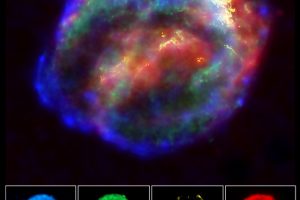Looking for compatc objects in the Kepler supernova remnant. Published on ApJ the study: “No Surviving Companion in Kepler’s Supernova” of P. Ruiz-Lapuente (Instituto de Física Fundamental, Madrid)

di Mario Giuseppe Guarcello ( follow mguarce)
Type Ia supernovae are particularly important in cosmology since they allow us precise measurements of the hosting galaxies. These supernovae are not triggered by the collapse of the core of massive stars, such as the “core-collapse supernovae”. They are instead due to the thermonuclear explosion of a white dwarf in close binary system. According to the nature of the companion and the explosion mechanism, three different scenarios of type Ia supernovae have been proposed. In the “single-degenerate” scenario the companion is a star, typically a giant, accreting material onto the white dwarf. Once the accreted mass is larger than a critical value, the thermonuclear explosion is triggered. The explosion can also be triggered by the coalescence of the white dwarf with its companion, which can be another white dwarf (the “double-degenerate scenario) or the core of a giant star (the “core-degenerate scenario”).
A possible way to distinguish between these three scenarios consists in searching for a survived companion in the supernova remnant produced by the supernova explosion. The companion in the single-degenerate Type Ia supernovae explosions may, in fact, survive the explosion, which is not expected to happen in the other two scenarios. These objects can be identified thanks to their large proper motion, fast rotation, brightness, and chemical peculiarities due to contamination by the supernova ejecta.
In the study “No Surviving Companion in Kepler’s Supernova” of P. Ruiz-Lapuente (Instituto de Física Fundamental, Madrid), which has been recently published by The Astrophysical Journal also with the collaboration of the astronomer F. Damiani of the Astronomical Observatory of Palermo, a possible survived object is searched in the Kepler supernova remnant, produced by the supernova SN 1604. This is one of the five historical supernovae, been observed by Johannes Kepler, together with other European, Korean and Chinese astronomers. The search for the compact object has been performed by analyzing high-resolution spectra obtained with FLAMES@ESO and data obtained with the Hubble Space Telescope of all the sources within the core of the supernova remnant. All the studied sources are compatible with being stars of different type, and no candidate survived companion is found. This result, together with some of the properties of the Kepler supernova remnant, led to the conclusion that the SN 1604 supernova was likely a “core-degenerate” Type Ia supernova.
The figure (link) shows a composite image of the Kepler supernova remnant (blue: high energy X-rays; green: low energy X-rays; blue: optical; red: infrared) obtained with the NASA satellites Chandra, Hubble and Spitzer.
